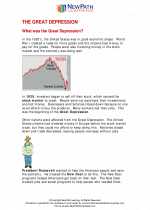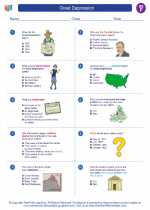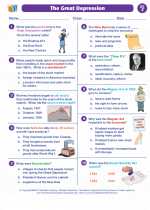Great Depression
In 1929, investors began to sell off their stock, which caused the stock market to crash. People were not paid back their investments and lost money. Businesses and factories closed down because no one could afford to buy the products. Many workers lost their jobs. This was the beginning of the Great Depression. Read More...
◂Social Studies Worksheets and Study Guides Sixth Grade. Great Depression
Study Guide Great Depression
Great Depression  Worksheet/Answer key
Worksheet/Answer key Great Depression
Great Depression  Worksheet/Answer key
Worksheet/Answer key Great Depression
Great Depression  Worksheet/Answer key
Worksheet/Answer key Great Depression
Great Depression  Worksheet/Answer key
Worksheet/Answer key Great Depression
Great Depression 

 Worksheet/Answer key
Worksheet/Answer key
 Worksheet/Answer key
Worksheet/Answer key
 Worksheet/Answer key
Worksheet/Answer key
 Worksheet/Answer key
Worksheet/Answer key

The resources above cover the following skills:
National Curriculum Standards for Social Studies (NCSS)
CULTURE
SOCIAL STUDIES PROGRAMS SHOULD INCLUDE EXPERIENCES THAT PROVIDE FOR THE STUDY OF CULTURE AND CULTURAL DIVERSITY.
KNOWLEDGE - Learners will understand:
That culture may change in response to changing needs, concerns, social, political, and geographic conditions.
TIME, CONTINUITY, AND CHANGE
SOCIAL STUDIES PROGRAMS SHOULD INCLUDE EXPERIENCES THAT PROVIDE FOR THE STUDY OF THE PAST AND ITS LEGACY.
KNOWLEDGE - Learners will understand:
Concepts such as: chronology, causality, change, conflict, complexity, multiple perspectives, primary and secondary sources, and cause and effect.
Key historical periods and patterns of change within and across cultures (e.g., the rise and fall of ancient civilizations, the development of technology, the rise of modern nation-states, and the establishment and breakdown of colonial systems).
INDIVIDUALS, GROUPS, AND INSTITUTIONS
SOCIAL STUDIES PROGRAMS SHOULD INCLUDE EXPERIENCES THAT PROVIDE FOR THE STUDY OF INTERACTIONS AMONG INDIVIDUALS, GROUPS, AND INSTITUTIONS.
KNOWLEDGE - Learners will understand:
That groups and institutions change over time.
PROCESSES - Learners will be able to:
Analyze the role of institutions in furthering both continuity and change.
National Standards for Civics and Government (NSCG)
What are the foundations of the American political system? What are the distinctive characteristics of American society?
Distinctive characteristics of American society. Students should be able to identify and explain the importance of historical experience and geographic, social, and economic factors that have helped to shape American society. To achieve this standard, students should be able to
Explain important factors that have helped shape American society
Market economy
How does the government established by the constitution embody the purposes, values, and principles of American democracy? What does the national government do?
Major responsibilities for domestic and foreign policy. Students should be able to explain the major responsibilities of the national government for domestic and foreign policy. To achieve this standard, students should be able to
Identify historical and contemporary examples of important domestic policies, e.g., Pure Food and Drug Act, Environmental Protection Act, civil rights laws, child labor laws, minimum wage laws, Aid to Families with Dependent Children, Social Security
Financing government through taxation. Students should be able to explain the necessity of taxes and the purposes for which taxes are used. To achieve this standard, students should be able to
Identify major uses of tax revenues received by the national government, e.g., direct payment to individuals (Social Security, Medicaid, Medicare, Aid to Families with Dependent Children), national defense, interest on the federal debt, interstate highways
National Content Standards in Economics (NCSE)
Allocation
Students will understand that different methods can be used to allocate goods and services. People acting individually or collectively must choose which methods to use to allocate different kinds of goods and services. Students will be able to use this knowledge to evaluate different methods of allocating goods and services, by comparing the benefits to the costs of each method.
At the completion of Grade 8, students will know the Grade 4 benchmarks for this standard, and also that:
There are essential differences between a market economy, in which allocations result from individuals making decisions as buyers and sellers, and a command economy, in which resources are allocated according to central authority.
Unemployment and Inflation
Students will understand that unemployment imposes costs on individuals and the overall economy. Inflation, both expected and unexpected, also imposes costs on individuals and the overall economy. Unemployment increases during recessions and decreases during recoveries. Students will be able to use this knowledge to make informed decisions by anticipating the consequences of inflation and unemployment.
At the completion of Grade 8, students will know the Grade 4 benchmark for this standard, and also that:
To be counted as unemployed, a person must be in the labor force. The labor force consists of people age 16 and over who are employed or actively seeking work. Thus the labor force is the sum of total employment and total unemployment.
At the completion of Grade 8, students will know the Grade 4 benchmark for this standard, and also that:
The unemployment rate is the percentage of the labor force that is willing and able to work, does not currently have a job, and is actively looking for work.
National Center for History in Schools (NCHS)
Historical Thinking Standards
Historical Comprehension
Reconstruct the literal meaning of a historical passage.
Historical Analysis and Interpretation
Analyze cause-and-effect relationships and multiple causation, including the importance of the individual, the influence of ideas.
United States History Content Standards
Era 7: The Emergence of Modern America (1890-1930)
How the United States changed from the end of World War I to the eve of the Great Depression.
The student understands how new cultural movements reflected and changed American society.
Era 8: The Great Depression and World War II (1929-1945)
The causes of the Great Depression and how it affected American society.
The student understands the causes of the crash of 1929 and the Great Depression.
The student understands how American life changed during the 1930s.
How the New Deal addressed the Great Depression, transformed American federalism, and initiated the welfare state.
The student understands the New Deal and the presidency of Franklin D. Roosevelt.
The student understands the impact of the New Deal on workers and the labor movement.
The student understands opposition to the New Deal, the alternative programs of its detractors, and the legacy of the New Deal.
Era 10: Contemporary United States (1968 to the present)
Recent developments in foreign and domestic politics.
The student understands domestic politics in contemporary society.
World History Content Standards
Era 8: A Half-Century of Crisis and Achievement, 1900-1945
The search for peace and stability in the 1920s and 1930s.
The student understands the interplay between scientific or technological innovations and new patterns of social and cultural life between 1900 and 1940.
The student understands the interplay of new artistic and literary movements with changes in social and cultural life in various parts of the world in the post-war decades.
Major global trends from 1900 to the end of World War II.
The student understands major global trends from 1900 to the end of World War II.
Era 9: The 20th Century Since 1945: Promises and Paradoxes
The search for community, stability, and peace in an interdependent world.
The student understands how liberal democracy, market economies, and human rights movements have reshaped political and social life.